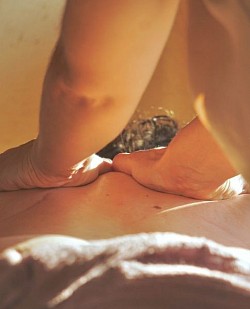What is myofascial release masaage therapy?
Myofascial Release Therapy (MFR) is a manual therapy technique used to treat soft tissue restrictions and alleviate pain
Myofascial Release Therapy (MFR) is designed to relieve pain, restore function, and improve overall well-being. Myofascial Release is a hands-on technique that targets the fascia, the connective tissue that surrounds and supports muscles, bones, and joints. Over time, physical stress, injury, poor posture, or repetitive movements can cause the fascia to become tight and develop adhesions, which may result in pain, stiffness, and restricted movement.
By using gentle, sustained pressure to release these fascial restrictions, restoring balance to the body and promoting long-lasting healing. Unlike traditional massage or other physical therapies, MFR focuses on both the superficial and deep layers of fascia to treat the underlying causes of pain rather than just masking the symptoms.
Myofascial Release (MFR) massage can be beneficial for a variety of medical conditions, especially those involving musculoskeletal pain, tightness, and limited mobility. Here are several medical conditions that MFR may help with:
1. Fibromyalgia: MFR can help manage the widespread pain and muscle stiffness associated with fibromyalgia by releasing tension in the fascia and improving circulation.
2. Chronic Back Pain: By addressing tight muscles and fascial adhesions, MFR can reduce pain and improve mobility in individuals with chronic back pain, including lower back and upper back issues.
3. Myofascial Pain Syndrome: This condition, characterized by muscle pain and trigger points (muscle knots), can be alleviated by MFR, which targets and releases these knots.
4. Carpal Tunnel Syndrome: MFR may help reduce the symptoms of carpal tunnel syndrome, such as pain, tingling, and numbness in the hands and wrists, by releasing tension in the forearm and hand muscles.
5. Temporomandibular Joint (TMJ) Disorder: MFR can help ease the muscle tension around the jaw and reduce the discomfort associated with TMJ dysfunction, such as jaw pain, headaches, and difficulty chewing.
6. Arthritis: While MFR doesn't cure arthritis, it can help alleviate pain and stiffness in the joints by releasing the fascia around the affected area and improving range of motion.
7. Sciatica: MFR can reduce the pain associated with sciatica by targeting the fascia and muscles in the lower back, hips, and legs, which often compress the sciatic nerve.
8. Headaches and Migraines: Tension headaches, including migraines, can benefit from MFR by releasing muscle tightness in the neck, shoulders, and upper back that often contributes to these headaches.
9. Postural Imbalances: MFR can help correct posture-related issues, such as rounded shoulders or forward head posture, which often cause pain in the back, neck, and shoulders.
10. Plantar Fasciitis: MFR can help relieve the pain associated with plantar fasciitis (heel pain) by releasing tightness in the fascia of the feet and calves.
11. Sports Injuries: MFR can assist with the healing of sports injuries such as strains, sprains, and tendonitis by targeting tight fascia and muscle tissue, improving flexibility, and promoting recovery.
12. Multiple Sclerosis (MS): While MFR cannot cure MS, it may help alleviate some of the pain, muscle spasticity, and mobility issues associated with the condition.
13. Scoliosis: MFR can help manage some of the pain and discomfort related to scoliosis by reducing muscle tension and improving flexibility in the spine and surrounding muscles.
While MFR is beneficial for many medical conditions, it should be used as a complementary therapy in conjunction with other medical treatments or therapies, and it’s important to consult with a healthcare professional before starting any new treatment.
About Hayley
Hayley Rance
Hayley is from the United Kingdom, specializing in soft tissue manipulation and trauma and emotional release therapy
Although Hayley is from the UK, she trained in myofascial therapy in Mexico, Mazunte and her healing hands has never stopped.
Hayley was inspired by this type of massage as it is linked to trauma and emotional release and now travels the world healing the body and unblocking energy, that can get stuck in the fascia.
Hayley has had many success stories in her myofascial release massage therapy sessions and has helped and healed so many people from all over the world changing there lives and living pain free
More Information
Myofascial tissue, which includes both muscle (myo) and connective tissue (fascia), is closely connected to the cells of the body through a network of fibers and signaling mechanisms. The fascia, which surrounds muscles, organs, and other structures, is made up of collagen and elastin fibers, creating a continuous web that supports and connects different parts of the body.
At the cellular level, fibroblasts, the primary cells in connective tissue, play a crucial role in maintaining the structure and function of the myofascial system. These cells produce and remodel the extracellular matrix (ECM), a substance that provides structural support to tissues. The ECM includes proteins such as collagen, which help transmit mechanical forces across tissues, and it plays an important role in cellular communication. Cells in the fascia, including fibroblasts and myofibroblasts, also respond to mechanical stress and stretch, influencing both the structure of the fascia and the behavior of surrounding muscle cells.
Additionally, the myofascial system is involved in cellular signaling through mechanotransduction, which is the process by which cells sense and respond to mechanical forces. This allows the body to adapt to physical activity or injury, promoting healing and maintaining structural integrity.
In summary, the myofascial system is not just a passive support structure, but an active and dynamic component of the body that interacts with the cells through mechanical and biochemical signals, helping to maintain the function and health of tissues.
Holistic Healing
Myofascial Release (MFR) massage is primarily focused on releasing physical tension in the muscles and fascia (the connective tissue surrounding muscles), but it can also be indirectly helpful in clearing or balancing the chakras, based on the idea that the physical body and energy systems (like chakras) are interconnected. Here’s how MFR might aid in clearing the chakras:
1. Releasing Blocked Energy: In many holistic traditions, it is believed that emotional or physical trauma can cause blockages in the energy flow within the body, including the chakras. MFR targets areas of muscular tension and fascia restriction, which can help release the trapped energy in those areas, allowing for better energy flow throughout the body. For example, tightness in the chest (related to the heart chakra) or the neck and throat (related to the throat chakra) may be alleviated, which could support clearing energy blockages.
2. Improving Posture and Alignment: MFR can help with postural imbalances, which often affect the alignment of the spine and the energy flow along the body. Proper alignment is important for the free flow of energy through the chakras, and when the body is aligned, the energy channels (or meridians) are more open, supporting chakra clearing.
3. Emotional Release: MFR is known to help release deeply held tension and trauma stored in the muscles and fascia. Some holistic practices suggest that emotions can become "stuck" in the body, especially in areas connected to specific chakras (e.g., fear in the root chakra, grief in the heart chakra). As MFR works on these areas, it may facilitate the release of emotional blockages, which can clear and balance the chakras.
4. Relaxation and Stress Reduction: MFR helps activate the parasympathetic nervous system, promoting relaxation and reducing stress. When the body is in a relaxed state, the energy system (including the chakras) can function more harmoniously. Reduced stress may lead to clearer energy pathways and more balanced chakras.
5. Awareness of Energy Flow: The physical sensations of MFR may help individuals become more attuned to the areas of their body where they feel tension or discomfort, which may correspond to specific chakras. This heightened awareness could aid in identifying and focusing on areas that may need energy clearing or healing.
While MFR isn’t typically classified as an energy-focused practice like Reiki or other chakra healing modalities, its physical benefits—like reducing muscle tension, improving circulation, and fostering relaxation—can support the overall balance and flow of energy throughout the body, indirectly aiding in chakra clearing. If you're specifically looking to work with chakras, MFR can be integrated into a broader holistic or energy healing practic
Location, Bookings and Workshops
Location
Mazunte, Mexico
November-May
8 Day Myofascial Workshop Febuary 2026
San Cristabol De Las Casas
May-November
8 Day Myofascial Workshop August 2026
Myofascial 8 day Workshop
For an 8-day Myofascial Release (MFR) massage workshop, the goal is to equip students with the knowledge and hands-on techniques needed to effectively release fascial restrictions and promote healing.
Day 1: Introduction to Myofascial Release
• Overview of Fascia: Structure, function, and importance in the body.
• Fascial Dysfunction: How fascia becomes restricted and its impact on movement and pain.
• Introduction to Myofascial Release Techniques: Basic concepts, benefits, and key principles.
• Posture & Body Mechanics: Importance of therapist posture for effective MFR.
Day 2: The Anatomy of Fascia
• Fascia Layers: Superficial, deep, and visceral fascia.
• Common Fascial Restrictions: Understanding where restrictions typically occur.
• Basic Anatomy Review: Focus on muscles, bones, and joints that interact with fascia.
• Palpation Skills: How to feel and assess fascial restrictions through touch.
Day 3: Myofascial Release Techniques – Part 1
• Hands-on Training: Techniques such as sustained pressure, gentle stretching, and lengthening of fascia.
• Working with the Upper Body: MFR techniques for shoulders, neck, and upper back.
• Client Assessment: How to assess client needs before starting MFR treatment.
Day 4: Myofascial Release Techniques – Part 2
• Lower Body MFR: Techniques for hips, pelvis, legs, and feet.
• Specialized Techniques: Addressing specific fascial patterns like trigger points, scar tissue, or adhesions.
• Integration of Breathing: Encouraging client breathing patterns to enhance release.
Day 5: Myofascial Release for Specific Conditions
• Chronic Pain: Understanding how MFR can help with conditions like fibromyalgia, sciatica, and tension headaches.
• Sports Injuries: MFR for muscle strains, sprains, and postural imbalances.
• Case Studies & Treatment Plans: Developing customized treatment plans for clients with different conditions.
Day 6: Advanced Myofascial Release Techniques
• Deep Myofascial Release: Techniques for deeper fascia layers and areas with more intense restrictions.
• Neurofascial Techniques: Addressing the nervous system’s role in fascia and pain.
• Complex Fascial Chains: Treating interconnected fascial lines and patterns.
Day 7: Practical Application and Case Studies
• Hands-on Practice: Extensive time for students to practice MFR techniques under instructor supervision.
• Client Assessment and Treatment Protocols: Reviewing client history, assessment, and MFR treatment options.
• Feedback & Discussion: Group sharing of experiences and questions.
Day 8: Review, Final Assessment, and Integration
• Comprehensive Review: Recap of all MFR techniques and concepts.
• Practical Exam: Assess students’ proficiency in performing MFR techniques.
• Post-Course Self-Care: Importance of self-care for the therapist to avoid burnout.
• Certification: Award certification
Throughout the workshop, there is a balanced mix of theory and hands-on practice, as students will benefit most from applying the techniques on each other and receiving feedback. This structure should provide a thorough grounding in Myofascial Release while preparing students to work with a variety of clients and conditions.
Any questions of bookings
Hayleyrance2014@gmail.com





